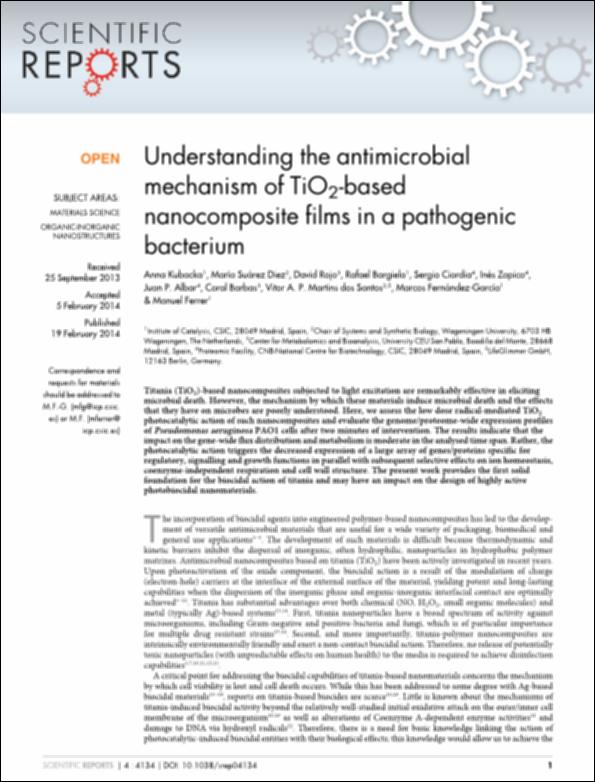Por favor, use este identificador para citar o enlazar este ítem:
http://hdl.handle.net/10637/7659Understanding the antimicrobial mechanism of TiO2-based nanocomposite films in a pathogenic Bacterium.
| Título : | Understanding the antimicrobial mechanism of TiO2-based nanocomposite films in a pathogenic Bacterium. |
| Autor : | Kubacka, Anna Suárez Diez, María Rojo Blanco, David Bargiela, Rafael Ciordia, Sergio Zapico, Inés Albar, Juan P. Barbas Arribas, Coral. Martins dos Santos, Victora A. P. Fernández-GarcÍa, Marcos Ferrer, Manuel |
| Materias: | Metabolitos. |
| Resumen : | Titania (TiO2)-based nanocomposites subjected to light excitation are remarkably effective in eliciting microbial death. However, the mechanism by which these materials induce microbial death and the effects that they have on microbes are poorly understood. Here, we assess the low dose radical-mediated TiO2 photocatalytic action of such nanocomposites and evaluate the genome/proteome-wide expression profiles of Pseudomonas aeruginosa PAO1 cells after two minutes of intervention. The results indicate that the impact on the gene-wide flux distribution and metabolism is moderate in the analysed time span. Rather, the photocatalytic action triggers the decreased expression of a large array of genes/proteins specific for regulatory, signalling and growth functions in parallel with subsequent selective effects on ion homeostasis, coenzyme-independent respiration and cell wall structure. The present work provides the first solid foundation for the biocidal action of titania and may have an impact on the design of highly active photobiocidal nanomaterials. |
| Descripción : | En: Scientific Reports. ESSN. 2045-2322. v. 4 (2014) 4134, DOI: 10.1038/srep04134 |
| URI : | http://hdl.handle.net/10637/7659 |
| Derechos: | http://creativecommons.org/licenses/by-nc-nd/4.0/deed.es |
| Fecha de publicación : | 16-sep-2014 |
| Centro : | Universidad San Pablo-CEU |
| Aparece en las colecciones: | Facultad de Farmacia |
Los ítems de DSpace están protegidos por copyright, con todos los derechos reservados, a menos que se indique lo contrario.


